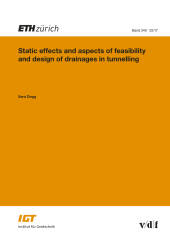 Neuerscheinungen 2017Stand: 2020-02-01 |
Schnellsuche
ISBN/Stichwort/Autor
|
Herderstraße 10
10625 Berlin
Tel.: 030 315 714 16
Fax 030 315 714 14
info@buchspektrum.de |

Sara Zingg
Static effects and aspects of feasibility and sesign of drainages in tunnelling
2017. XVI, 212 S. zahlr. Abb., farbig. 29.7 cm
Verlag/Jahr: VDF HOCHSCHULVERLAG AG 2017
ISBN: 3-7281-3819-3 (3728138193)
Neue ISBN: 978-3-7281-3819-4 (9783728138194)
Preis und Lieferzeit: Bitte klicken
This PhD thesis investigates the effectiveness of drainage measures with respect to two particularly important problems associated with tunnelling through water-bearing, weak ground: the stability of the tunnel face and the stability and deformation of grouting bodies. Water is an adverse factor with respect to the stability and deformation of underground structures due to the pore water pressure and the seepage forces associated with seepage flow towards the tunnel. Drainage boreholes reduce the pore water pressure and the seepage forces in the vicinity of the cavity. Furthermore, loss of pore water pressure increases the effective stresses and thus the shearing resistance of the ground ("consolidation"), which is favourable in terms the deformation occurring during and after tunnelling.
Water has a negative effect on the stability of underground openings due to the seepage force which it exerts towards the cavity. One of the most serious risks in water-bearing, low strength ground is a collapse of the tunnel face. In shallow tunnels, the instability may propagate upwards thus creating a chimney in the ground and a crater on the ground surface. In deep tunnels crossing fault zones under high pore water pressure, potential hazards include high water inflows or even a complete flooding of the tunnel in the case of a hydraulic connection to the seabed. Advance drainage is favourable with respect to stability because it decreases both the pore pressure and its gradient in the vicinity of the cavity. Advance drainage measures are common for stabilizing the tunnel face in conventional tunnelling through weak ground and are used to overcome tunnel sections in water-bearing fault zones consisting of cohesionless ground, typically in combination with advance grouting.
There is a series of geological, operational or economic factors which may limit the feasibility or static effectiveness of drainages. Decisive for pore pressure relief in the ground and thus key factors in predimensioning drainage measures are the length, number, geometric layout, diameter and casings of the drainage boreholes. However in ground of low permeability, the time available to achieve a relevant pore pressure relief may be insufficient for tunnelling practice. On the other hand in ground of high permeability, the water inflows into the boreholes may be so large that the hydraulic capacity of the boreholes (or of the pumping system installed on site) may result in reduced pore pressure relief in the surrounding ground. Heterogeneous formations consisting of aquitards and aquifers are a challenge because only drainage of the more permeable layers results in a significant pore pressure relief. In addition, project constraints (e.g. water protection, admissible settlements) may limit drainage measures or even render them impossible.
Although drainage belongs to the most important measures in tunnelling practice, relatively few investigations have been made into the effects of the aforementioned factors, which are decisive for the success of drainage. The present thesis takes this as its starting point: Ms Zingg provided the first comprehensive insight into the static effects of drainages in tunnelling when considering a series of factors influencing both feasibility and design. She examined the key factors of drainage measures theoretically, improved the understanding of the static effects for two particularly important stability problems in tunnelling and provided valuable design aids for practice.
Zurich, January 2017
Prof. Dr. Georg Anagnostou


